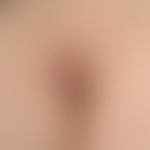Synonym(s)
HistoryThis section has been translated automatically.
DefinitionThis section has been translated automatically.
Acute or chronic inflammation in the subcutaneous fatty tissue, starting from the midline of the sacral region (pilus = hair; nidus = nest). A distinction is made between asymptomatic, acute abscessing and chronic forms. In principle, pilonidal sinuses can also occur in other regions of the body, for example umbilically and interdigitally in hairdressers as trichogenic foreign body granulomas.
You might also be interested in
Occurrence/EpidemiologyThis section has been translated automatically.
Mostly occurring in Caucasians. Asians are practically not affected. The incidence is about 20/100.000 inhabitants.
EtiopathogenesisThis section has been translated automatically.
Acquired, multifactorial disease with questionable genetic disposition. Probably, rubbing movements of the nates lead to the impaling of hairs into the opposite skin down to the subcutaneous fatty tissue with subsequent development of a chronic, non-healing foreign body granuloma.
An analogous mechanism is found with the so-called hairdresser's granuloma (impaling of hair) or with the milker's granuloma.
Pilonidalsinus in chronic inflammatory follicular processes, especially in acne inversa and hidradenitis suppurativa, receive a different etiological evaluation.
ManifestationThis section has been translated automatically.
Mostly occurring in young, very hairy men with predominantly sedentary occupation (car drivers, motorcyclists). Men are 2-4 times more frequently affected than women. Occurrence in the context of acne tetrade possible.
LocalizationThis section has been translated automatically.
Clinical featuresThis section has been translated automatically.
No complaints in the inflammation-free stage. In the Rima ani, one or more, possibly small fistula openings can be seen, often with ingrown hairs. Tendency to extensive, persistent, abscessing inflammation due to chronic friction and maceration (redness, fluctuation, severe pain, possibly extensive, fox-like fistulations with secondary openings). In the chronic stage, patients suffer from serous malodorous secretions from the sinus, which considerably restrict everyday life.
HistologyThis section has been translated automatically.
Differential diagnosisThis section has been translated automatically.
Complication(s)This section has been translated automatically.
TherapyThis section has been translated automatically.
Conservative forms of therapy have not proven to be curative (Melnik B et al. 2018).
External therapyThis section has been translated automatically.
Operative therapieThis section has been translated automatically.
The incision is the method of choice for acute abscesses. The optimal location of the incision on the apex of the abscess cavity can be determined by palpation ("doughy dent") and sonography. Intradermal local anaesthesia is preferable to icing in terms of analgesia and avoidance of CFCs. Dermatological biopsy punches with a diameter of 6 mm are suitable for making the incision. The circular canopy thus created usually allows for tamponade-free follow-up treatment.
The radical excision should not yet be performed at this stage because of the high recurrence rate. After the inflammation has subsided, complete excision of the foci (en bloc excision) with subsequent secondary healing is considered standard. Routine excision down to the sacral fascia must be avoided at all costs, since it often causes pain that is resistant to therapy despite recurrence-free healing of the wound.
Primary openings to the side of the midline (off-midline pits), lateral passages and ramifications are untypical of pilonidal fistulas and suggest an inverse acne with a correspondingly less favourable prognosis. Experience shows that the granulation and epithelization phase lasts at least 8 weeks, but can last up to a year depending on the size.
In the inflammation-free interval, operative rehabilitation, if necessary after previous fistula presentation. Generous excision of the pilonidal sinus and all fistulas up to the sacrococygeal fascia. Subsequently secondary healing of the wound.
In order to ensure granulation from the depths, the use of a special pouring procedure, e.g. Cavi-Care, has proven to be effective. The deep wound is poured out with the two-component plastic and the resulting plug is fixed with a self-adhesive foil. This tamponade must be cleaned daily and placed back into the cavi-care. After about 8 days the tamponade must be poured again, as the wound cavity is rapidly shrinking.
As an alternative to secondary healing, the wound can be treated primarily with sutures or by plastic reconstructive surgery.
Note: The lowest recurrence rate of 0-13% is said to be excisions with secondary wound healing. However, a review by Iesalnieks et al (Lesalnieks I et al. 2019) indicates a recurrence rate of up to 57%. In primary surgery, recurrence rates in plastic reconstruction according to Karydakis < 5 % are realistic.
Progression/forecastThis section has been translated automatically.
ProphylaxisThis section has been translated automatically.
NaturopathyThis section has been translated automatically.
Note(s)This section has been translated automatically.
Incorrect synonyms for the disease are the terms coccygeal moid, sacraldermoid, dermoid cyst, coccygeal fistula and raphefiste.
A generally accepted classification for the severity of pilonidal sinus is still missing (Beal EM et al. 2019).
LiteratureThis section has been translated automatically.
- Beal EM et al (2019) A systematic review of classification systems for pilonidal sinus.
- Tech Coloproctol doi: 10.1007/s10151-019-01988-x.
- Bradley L (2010) Pilonidal sinus disease: a review. Part one.
- J Wound Care 19:504-508.
- De Martino C (2011) Squamous-cell carcinoma and pilonidal sinus disease. Case report and review of literature. Ann Ital Chir 82:511-514.
- Hegele A et al (2003) Reconstructive surgical therapy of infected pilonidal sinus. Surgeon 74: 749-752
- Hodges RU (1880) Pilonidal sinus. Boston Med Surg J 103: 485
- Karydakis G (1992) Easy and successful treatment of pilonidal sinus after explatnation of its causative process. Anz Journal of Surgery 62: 385-389.
- Lesalnieks I et al (2019) The management of pilonidal sinus. Dtsch Arztebl Int116: 12-21.
- Melnik B et al (2018) Acne and rosacea. In: Braun-Falco`s Dermatology, Venerology Allergology G. Plewig et al. (Hrsg) Springer Verlag S 1324
- Testini M et al (2001) Treatment of chronic pilonidal sinus with local anaesthesia: a randomized trial of closed compared with open technique. Colorectal Dis 3: 427-430
- Sondenaa K et al (2002) Influence of failure of primary wound healing on subsequent recurrence of pilonidal sinus. combined prospective study and randomised controlled trial. Eur J Surg 168: 614-618
- Downs AM, Palmer J (2002) Laser hair removal for recurrent pilonidal sinus disease. J Cosmet Laser Ther 4: 91
- Matsushita S et al (2002) A case of squamous cell carcinoma arising in a pilonidal sinus. J Dermatol 29: 757-758
Incoming links (20)
Abscess, pilonidal; Acne tetrade; Coccygeal fistula; Coccygeal fistula; Coccyx cyst; Coccyx fistula; Cyst; Dermoid cyst; Fistula; Hair fistula; ... Show allOutgoing links (7)
Abscess, periproctitic; Acne inversa; Acne tetrade; Anal fistula; Hairdressing granuloma; Milker granuloma; Suppurative hidradenitis;Disclaimer
Please ask your physician for a reliable diagnosis. This website is only meant as a reference.







